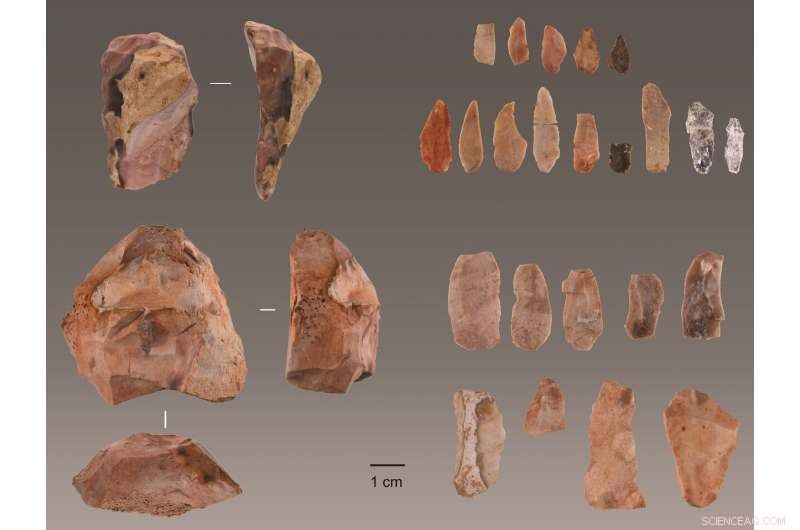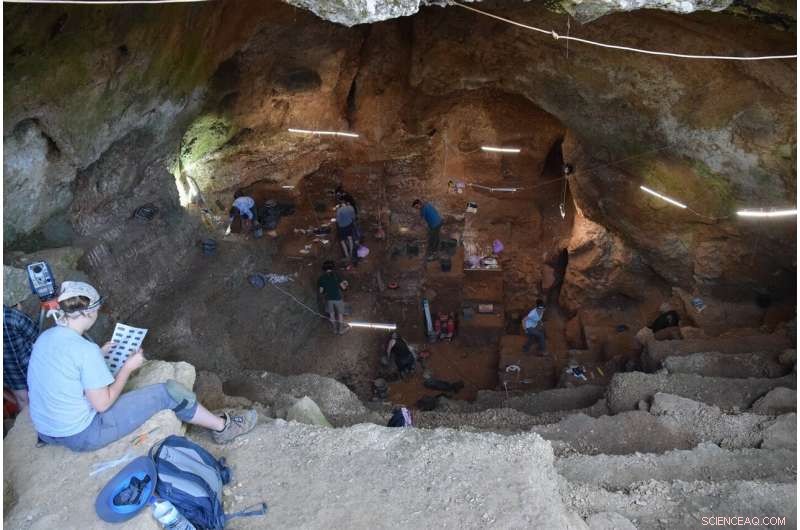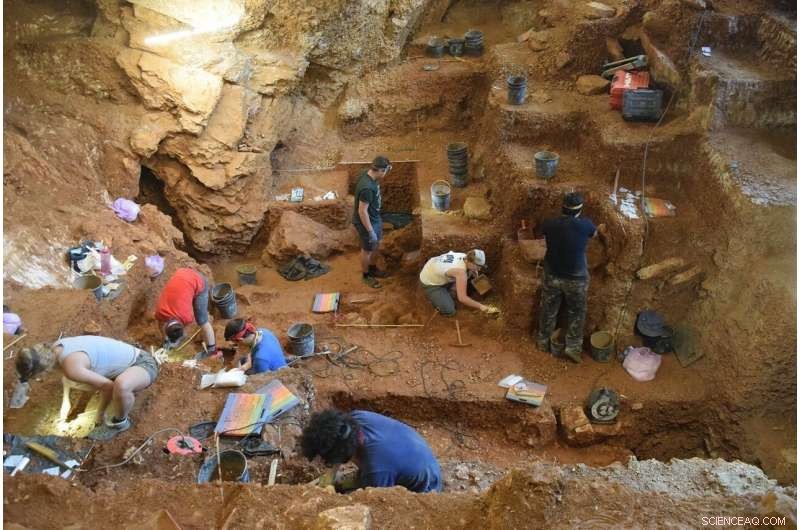
Outils découverts à Lapa do Picareiro dans le centre du Portugal. Crédit :Jonathan Haws.
Les humains modernes sont arrivés dans la partie la plus occidentale de l'Europe 41, 000—38, il y a 000 ans, Environ 5, 000 ans plus tôt qu'on ne le savait auparavant, selon Jonathan Haws, Doctorat., professeur et président du Département d'anthropologie de l'Université de Louisville, et une équipe internationale de chercheurs. L'équipe a révélé la découverte d'outils en pierre utilisés par les humains modernes datant de la période antérieure dans un rapport publié cette semaine dans le journal Actes de l'Académie nationale des sciences .
Les outils, découvert dans une grotte nommée Lapa do Picareiro, situé près de la côte atlantique du centre du Portugal, relier le site avec des trouvailles similaires de toute l'Eurasie à la plaine russe. La découverte soutient une dispersion rapide vers l'ouest des humains modernes à travers l'Eurasie quelques milliers d'années après leur première apparition dans le sud-est de l'Europe. Les outils documentent la présence d'humains modernes dans l'extrême ouest de l'Europe à une époque où l'on pensait auparavant que les Néandertaliens étaient présents dans la région. La découverte a des ramifications importantes pour comprendre l'interaction possible entre les deux groupes humains et la disparition ultime des Néandertaliens.
"La question de savoir si les derniers Néandertaliens survivants en Europe ont été remplacés ou assimilés par l'arrivée des humains modernes est une question de longue date, problème non résolu en paléoanthropologie, " a déclaré Lukas Friedl, anthropologue à l'Université de Bohême occidentale à Pilsen, République Tchèque, et co-chef de projet. "Les premières dates des outils de pierre aurignaciens à Picareiro excluent probablement la possibilité que les humains modernes soient arrivés dans le pays longtemps dépourvu de Néandertaliens, et c'est en soi excitant."
Jusqu'à maintenant, la plus ancienne preuve de l'homme moderne au sud de l'Èbre en Espagne provenait de Bajondillo, un site de grottes sur la côte sud. La découverte des tabourets de pierre caractérisés comme aurignaciens, technologie associée aux premiers humains modernes en Europe, dans un contexte stratigraphique sécurisé à Picareiro fournissent des preuves définitives de l'arrivée de l'homme moderne.
"Bajondillo a offert des preuves alléchantes mais controversées que les humains modernes étaient dans la région plus tôt que nous ne le pensions, " a déclaré Haws. " Les preuves de notre rapport soutiennent définitivement les implications de Bajondillo pour une arrivée humaine moderne, mais on ne sait toujours pas comment ils sont arrivés ici. Les gens ont probablement migré le long des rivières qui coulent d'est en ouest à l'intérieur, mais une route côtière est encore possible."
"La propagation des humains anatomiquement modernes à travers l'Europe il y a plusieurs milliers d'années est au cœur de notre compréhension de notre origine en tant qu'espèce désormais mondiale, " dit John Yellen, directeur du programme d'archéologie et d'archéométrie à la National Science Foundation, qui a soutenu le travail. "Cette découverte offre de nouvelles preuves importantes qui aideront à façonner les futures recherches sur le moment et l'endroit où les humains anatomiquement modernes sont arrivés en Europe et les interactions qu'ils ont pu avoir avec les Néandertaliens."

Vue de Lapa do Picareiro à la recherche de l'entrée. Crédit :Jonathan Haws
La grotte de Picareiro est en fouille depuis 25 ans et a produit un record d'occupation humaine au cours des 50 dernières, 000 ans. Une équipe de recherche internationale du Centre interdisciplinaire d'archéologie et d'évolution du comportement humain (ICArEHB) de Faro, Le Portugal, étudie l'arrivée des humains modernes et l'extinction des Néandertaliens dans la région.
Le projet est dirigé par Haws, Michael Benedetti de l'Université de Caroline du Nord Wilmington, et Friedl, en collaboration avec Nuno Bicho et João Cascalheira de l'Université de l'Algarve, où est hébergé l'ICArEHB, et Telmo Pereira de l'Université autonome de Lisbonne.
Avec le soutien des subventions de la National Science Foundation des États-Unis à Haws et Benedetti, l'équipe a découvert de riches gisements archéologiques qui incluent des outils de pierre en association avec des milliers d'ossements d'animaux provenant de la chasse, activités de boucherie et de cuisine.
Sahra Talamo de l'Université de Bologne, Italie, et l'Institut Max Planck d'anthropologie évolutive à Leipzig, Allemagne, joined the research team to determine the age of the early modern human and Neanderthal occupations. She used state-of-the-art bone pretreatment and accelerator mass spectrometry (AMS) to date the bones that show evidence of butchery cut marks and intentional breakage by humans to extract bone marrow, a highly prized and nutritious food consumed by ancient people. The dating results place the modern human arrival to the interval between 41, 000 and 38, il y a 000 ans. The last Neanderthal occupation at the site took place between 45, 000 and 42, il y a 000 ans.
"The radiocarbon results from Lapa do Picareiro are not only very precise in terms of the dating method, but also demonstrate the meticulous work of the archeologists at the site, " Talamo said. "The importance of collaboration between the radiocarbon specialist and the archaeologists is essential in order to obtain an accurate chronology like in the case of Picareiro."
Spatial analysis of high-resolution three-dimensional data confirmed the precise stratigraphic relationships between artifacts and radiocarbon samples and revealed discrete layers of occupation at the site.
"Analysis of high-resolution spatial data is crucial for documenting and observing lenses of human occupation and reconstructing occupational patterns, especially in cave environments where complex formation processes exist, " said Grace Ellis, un doctorat student at Colorado State University studying landscape archaeology and ancient settlement patterns.

View of the excavation of the early modern human (foreground) and Neanderthal layers (background) of Lapa do Picareiro. Credit:Jonathan Haws
This was backed up by artifact refitting that showed the stone tools were not moved through post-depositional processes.
"Refitting is a task that requires a lot of time and patience, and in this case, it really was worthwhile because the results verified the geospatial observations, " said Pereira, an archaeologist who specializes in stone technology.
While the dates suggest that modern humans arrived after Neanderthals disappeared, a nearby cave, Oliveira, has evidence for Neanderthals' survival until 37, il y a 000 ans. The two groups may have overlapped for several thousand years in the area.
"If the two groups overlapped for some time in the highlands of Atlantic Portugal, they may have maintained contacts between each other and exchanged not only technology and tools, but also mates. This could possibly explain why many Europeans have Neanderthal genes, " said Bicho, director of ICArEHB.
"Besides genetic and archeological evidence, high-resolution temporal context and fossil evidence across the continent is crucial for answering this question. With the preserved key layers dated to the transitional period, we are now awaiting human fossils to tell us more about the nature of the transition, " Friedl said.
Despite the overlap in dates, there does not appear to be any evidence for direct contact between Neanderthals and modern humans. Neanderthals continued to use the same stone tools they had before modern humans arrived, bringing a completely different stone technology.
"Differences between the stone tool assemblages dated before and after about 41, 000 years ago are striking at Picareiro, " said Cascalheira, an ICArEHB board member and specialist on stone tool technology. "Older levels are dominated by quartzite and quartz raw materials and marked by the presence of Levallois technology, a typical element of Neanderthal occupations in Europe. Aurignacian levels, d'autre part, are dominated by flint and the production of very small blades that were likely used as inserts in arrow shafts for hunting."
Flint also was used to make tools for butchering animals such as red deer, ibex and possibly rabbits. The team recovered a few red deer canine teeth, often used as personal adornments, but so far these do not show traces of manufacturing jewelry.
"The bones from Lapa do Picareiro make up one of the largest Paleolithic assemblages in Portugal, and the preservation of these animal bones is remarkable, " said Milena Carvalho, un doctorat candidate at the University of New Mexico and ICArEHB researcher studying the diets and paleoecology of Neanderthals and modern humans. "The collection will provide tremendous amounts of information on human behavior and paleoecology during the Paleolithic and we will be studying it for decades."
The cave sediments also contain a well-preserved paleoclimatic record that helps reconstruct environmental conditions at the time of the last Neanderthals and arrival of modern humans.
"We studied changes in the size of limestone clasts and the chemistry of muddy fine sediment filling the cave to understand the paleoclimatic context for the transition, " Benedetti said. "Our analysis shows that the arrival of modern humans corresponds with, or slightly predates, a bitterly cold and extremely dry phase. Harsh environmental conditions during this period posed challenges that both modern human and Neanderthal populations had to contend with."
The cave itself has an enormous amount of sediment remaining for future work and the excavation still hasn't reached the bottom.
"I've been excavating at Picareiro for 25 years and just when you start to think it might be done giving up its secrets, a new surprise gets unearthed, " Haws said. "Every few years something remarkable turns up and we keep digging."